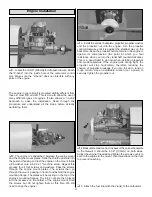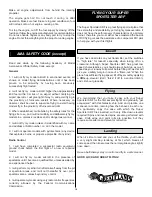
If you are using a hobby knife, do not cut the wood
under the covering! This will seriously weaken the
stabilizer and could easily cause the stabilizer to break
in flight.
If the fin breaks, the plane has a very good chance of
crashing. It is best to be
very careful
when making this cut
not to cut into the wood. The covering must be removed from
the bottom of the fin, or the bond between the fuselage and
fin will be insufficient and the fin may simply come off in flight.
❏
9. Remove the fin and mix up 1/4 oz. [7ml] of 30-minute
epoxy. Using a mixing stick, apply epoxy to the fuselage.
Apply epoxy to the bottom of the fin where the balsa wood
is exposed. Place the fin into the fuselage. Check to make
sure the fin is perpendicular to the stabilizer when viewed
from the rear of the airplane. (Use the sketch as a guide for
checking the alignment.) Check this alignment with the
fuselage (previous step) and stabilizer several times as the
epoxy cures. You may find it beneficial to hold the fin in place
using masking tape and T-pins until the epoxy has cured.
❏
1. Bend one of the tubes (referred to as the vent tube) upwards
at a 45º angle. Heating the tube will make the bending
process much easier. Be
very
careful not to melt the tube
during the bending process.
Note:
When the stopper
assembly is installed into the fuel tank, the vent tube should
be 1/16" [1.5mm] from the top of the tank.
❏
2. Locate the metal fuel pick-up weight (often referred to
as the “clunk”) and cut a 4" [102mm] piece of silicone fuel
tubing (not included). Install the clunk onto the tubing. Slide
the other end of the tubing onto the unbent tube. Measure
the distance from the end of the clunk to the back of the
stopper. Position the fuel tube so the distance measures
5" [127mm].
❏
3. The stopper assembly can now be inserted into the tank.
The vent tube should be adjusted so the vent tube is pointed
up towards the top of the tank. The rubber stopper must seat
against the lip of the tank. Make sure the tubes are
positioned side-to-side. Check to make sure the vent tube is
1/16" [1.5mm] from the top of the tank. Also, check to make
sure the clunk can move freely inside the tank, without
catching on the end of the tank. (It should clunk around in
the tank!) Once everything checks out, tighten the screw to
secure the stopper into the tank.
Don’t overtighten the screw
and strip out the rear compression disk!
It would be a
good idea to mark which tube is the vent tube at this time.
❏
4. Insert the fuel tank into the fuselage. The vent tube will
face towards the top of the fuselage.
❏
5. Cut two pieces of fuel tubing (not included) 5" [127mm]
in length. Attach these to the tubes on the fuel tank. You may
need to hold the tank in position with one hand while
installing the tubes with the other.
Fuel Tank Installation
10






































